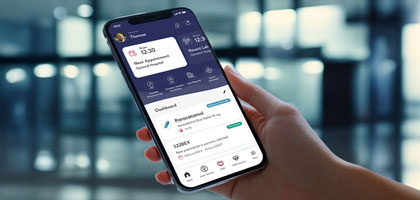
Blog
This Month in Healthcare IT: Remarkable e-Health News in April
In the evolving world of healthcare technologies, maintaining a competitive edge is essential for success and better healthcare information technologies. At Tiga Healthcare Technologies, we are devoted to keeping up with the latest industry developments, from global paradigm shifts toward patient centricity to recent reports' insights; it's all fuel for our mission: revolutionizing healthcare IT and delivering better care for all. It's this constant learning that pushes us forward, strengthening our position as a global leader who shapes the future of healthcare IT technologies.
Our leadership's dependence on knowledge defines our presence. The future of healthcare IT is full of challenges but at Tiga, we're ready with a mindset of innovative solutions and competent human resources. This blog series is a testament to our loyalty to this cause, providing insights into the significant advancements that drive our innovations. We're delighted to showcase the healthcare IT developments that have grabbed our attention from April until today.
Here are the top 11 news that have inspired us:
1. The European Parliament has adopted the European Health Data Space (EHDS) regulation, paving the way for a more connected healthcare system in the EU.

The European Parliament has finally approved the creation of the inter-institutional European Health Data Space (EHDS), enabling easier access to healthcare data for citizens and healthcare professionals through two key platforms: My Health EU and Health Data EU. This law governs safer and quicker healthcare data transfer within the EU, including patient summaries, prescriptions, imagery and lab results. It significantly impacts individuals' rights to their health data and promotes its reuse. EHDS empowers individuals to access data via portals or apps, aligning with Europe's Digital Decade Programme for 2030. The regulation also ensures that data accompanies patients seeking care across the EU, establishes access bodies for patient-centric treatments and accelerates healthcare research for new methods.
2. The World Bank, World Health Organization (WHO), Geneva Digital Health Hub (gdhub) and World Trade Organization (WTO) have jointly published a provisional draft report titled 'Cross-Border Telehealth Practice: Policy Considerations.'

The World Health Organization (WHO), Geneva Digital Health Hub (gdhub), World Trade Organization (WTO) and The World Bank have collectively published an initial draft report addressing policy considerations regarding cross-border telehealth practices. This collaborative exertion investigates the dynamic intersection of technology, healthcare and globalization, encompassing the matrix of fundamental aspects, advancements and regulatory frameworks.
3. The European Commission establishes the Critical Medicines Alliance to improve the drug supply chain's safety and prevent shortages.

The European Commission's Health Emergency Preparedness and Response Authority (HERA) and the Belgian Presidency of the Council of the EU have jointly introduced the Critical Medicines Alliance. It aims to tackle shortages of critical medicines, aligning to support the European Health Union and respond to calls from over 23 Member States for increased strategic autonomy in the pharmaceutical sector. The Alliance will develop strategic recommendations to mitigate shortages and vulnerabilities in the supply chain. These purposes will ultimately contribute to a more resilient and sustainable European pharmaceutical industry and more secure medicine supplies for citizens.
Source: https://ec.europa.eu/commission/presscorner/detail/en/ip_24_2229
4. WHO Europe published a country profile collection titled 'Exploring the digital health landscape in the WHO European Region.'

The WHO Regional Office for Europe published a collection of country profiles on digital health pulled from their 2022 Digital Health Survey. These profiles organize data into seven themes, including digital health foundations, electronic health records, national digital health patient portals, telehealth programs, mHealth services and programs, health-related mobile apps, big data and advanced analytics. Involving many countries from Albania to Uzbekistan, the report provides both a color-coded summary of key findings and in-depth profiles for individual countries.
Source: https://gateway.euro.who.int/en/datasets/digital-health/
5. The US Food and Drug Administration (FDA) launches the 'Home Healthcare Hub' to address healthcare equity issues.

The Food and Drug Administration (FDA) announced a new augmented reality (AR) and virtual reality (VR) initiative, Home as a Health Care Hub, as a part of the broader effort to promote health equity by moving preventative and treatment options into the home setting. Currently, home healthcare often relies on devices designed for clinical settings rather than the home environment. This initiative aims to create a VR prototype of a home designed for healthcare delivery that meets the needs of different living situations and offers solutions for underserved communities. The goal is to develop user-friendly home-based healthcare solutions, improve patient outcomes and reduce healthcare costs.
6. The WHO revealed a new digital health promoter based on generative AI for advanced population health efforts.

The WHO introduced S.A.R.A.H. (Smart AI Resource Assistant for Health), a generative AI product that covers key health topics in multiple languages. It offers guidance on lifestyle habits, disease prevention and mental health by providing real-time and empathetic responses. Moreover, it aids in comprehending risk factors for major global causes of death, such as cancer, heart disease and diabetes. Overall, it aims to empower population health with enhanced access to health resources.
7. Horizon Europe gets a funding increase to focus on healthcare, specifically fighting future pandemics.

The European Commission boosted Horizon Europe's 2023-24 Work Program funding for further research and innovation. The amendment mobilizes previously unallocated funding by nearly €1.4 billion to a total of €7.3 billion. A significant portion, nearly €650 million, will be invested in European Union Missions, largely focusing on healthcare. Most importantly, the amendment highlights detection, prevention, fighting and managing outbreaks of diseases to help equip Europe for potential future pandemics with high technology.
Source: https://ec.europa.eu/commission/presscorner/detail/en/IP_24_2104
8. The Centers for Disease Control and Prevention (CDC) released the 'Public Health Data Strategy' to rapidly accelerate the US's ability to respond to health threats.

The Centers for Disease Control and Prevention (CDC) released an updated Public Health Data Strategy for 2024-2025 alongside a 2023 Lookback Report. The center aims to rapidly respond to health threats by enhancing data sharing between healthcare and public health entities.
Key 2023 achievements include advanced electronic case reporting and real-time data sharing, especially in rural hospitals and expanded sharing of emergency data with the CDC. Most importantly, the CDC launched a new Respiratory Virus Data Channel for real-time COVID-19, flu and RSV data. Future efforts focus on accelerating electronic case reporting adoption, integrating public health with health IT for faster data sharing, expanding critical data sources and addressing health disparities.
Source: https://www.cdc.gov/media/releases/2024/p0411-CDC-data-modernization.html
9. The Office of the National Coordinator for Health Information Technology (ONC) published Common Agreement Version 2.0, facilitating TEFCA exchange through FHIR.

The US Department of Health and Human Services, through the Office of the National Coordinator for Health Information Technology (ONC) and The Sequoia Project, Inc., released the Common Agreement Version 2.0 (CA v2.0). This agreement establishes a technical infrastructure model and governing approach for health information networks to share clinical information securely. Seven Qualified Health Information Networks (QHINs) under the Trusted Exchange Framework and Common Agreement (TEFCA) can now adopt and implement this new version.
CA v2.0 includes enhancements to support Fast Healthcare Interoperability Resources (FHIR) API exchange. These updates facilitate easier information exchange and enable individuals to access their health information through apps of their choice. These updates represent significant progress for TEFCA in achieving seamless nationwide exchange at scale.
Source: https://www.hhs.gov/about/news/2024/04/22/onc-releases-common-agreement-version.html
10. Microsoft Cloud for Healthcare released its 2024 release wave 1 for improved clinical and operational insights.

The 2024 release wave 1 of Microsoft Cloud for Healthcare, running from April to September, is set to enhance its platform capabilities. This document includes integrating advanced clinical and operational insights and simplifying the development of FHIR applications using low-code tools. The system, designed to manage healthcare data on a large scale, is focused on improving patient experiences, streamlining care coordination and optimizing operational efficiency. By combining the power of Microsoft Dynamics 365, Microsoft Fabric, Microsoft Purview, Microsoft 365 and Microsoft Azure AI, this platform offers advanced analytics for managing both clinical and operational healthcare data.
Source: https://learn.microsoft.com/en-us/industry/release-plan/2024wave1/cloud-healthcare/
11. The Ministry of National Guard Health Affairs in Riyadh significantly reduces outpatient no-shows with AI.

The Ministry of National Guard Health Affairs' Riyadh-based hospital, King Abdulaziz Medical City, achieved Stage 7 in four different HIMSS models, marking a significant global milestone. Recently, it reached Stage 6 on another model, demonstrating its adherence to digital health transformation. With 1.3 million patients, the hospital's advanced use of health information and technology has been highly beneficial. One standout achievement has been the reduction of outpatient no-shows, a common challenge in global healthcare. The Ministry has made substantial progress in predicting and managing potential no-shows using AI and machine learning algorithms. Integrated AI within its electronic health record system enables proactive identification of at-risk patients, facilitating timely reminders and appointment bookings, ultimately enhancing care delivery and patient outcomes.
Source: https://www.healthcareitnews.com/news/saudi-arabia-machine-learning-helps-reduce-outpatient-no-shows

Highlighted reports, healthcare IT developments and legislative changes paint a clear picture. Genuine digitalization and proper implementation are the future of healthcare success in 2024 and beyond.
As we all aspire to progress, finding the right tools and conditions can be challenging. At Tiga, we support you at every step of your healthcare IT journey with innovative solutions and support. Recent developments underscore the central places of patient-centricity and data privacy in healthcare IT, which is why we've invested heavily in secure healthcare data management. For example, our Personal Health Record (PHR) product, compliant with the European Health Data Space, offers patients a safe and integrated way to access their health information.
Plus, our worldwide efforts yield results in national patient portals and AI & Analytics solutions, where WHO Europe's recent report points out the strengthening needs of European countries. Research on pandemic detection and prevention technologies, supported by significant funding allocations in Horizon Europe 2023-24, shows the success of the vision behind our early warning system, Predis.
We stand ready to support countries like the recently formed European Critical Medicines Alliance with our Pharmaceutical Track & Trace System, branded as DrugXafe. It's the world's first pharmaceutical tracking system designed to ensure drug safety and integrity throughout the supply chain, earning it the WSIS championship twice.
We aim for a better future for healthcare systems and offer reliable products that comply with global standards for increased accessibility of digitalized healthcare. This vision gives valuable results with our Healthcare Interoperability, Patient Engagement, Prescription and medicine Management, Drug Traceability, AI & Analytics, Population Health Management, Personalized Healthcare and Hospital Information System product families. Healthcare IT developments are our game. We're not just playing; we're redefining the rules. Let's shape the future together, as always!









